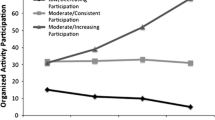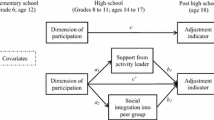Abstract
The goal of this study was to examine initial levels and rates of change in the intensity and breadth of participation in organized activities during the adolescent years, and how these participation practices were related to youth outcomes in later adolescence. The main objectives were (a) to examine growth curves of intensity and breadth of participation from Grades 7 through 11 and their interrelations, and (b) to test the associations between these dimensions of participation and academic orientation, risky behaviors, internalizing problems, and civic development in Grade 11. A homogenous sample of 299 youth (mean age = 13.37, SD = .41; 62% girls) were surveyed annually using questionnaires and phone interviews. The main results revealed that (a) even though both intensity and breadth of participation decreased over time, intensity of participation showed steeper declines by later grades, and (b) initial levels of participation were better predictors of later outcomes than rates of change over time. Regardless of the levels of change taking place over time, results revealed that youth with high initial levels of participation (both intensity and breadth) were more committed to school and developed more positive values towards society by Grade 11 than those who participated less. This might suggest that a high level of participation during early-to-mid-adolescence is particularly important when it comes to later outcomes.

Similar content being viewed by others
Notes
To improve model fit, correlations had to be added between the residual errors of intensity and breadth in Grades 8, 10, and 11 (standardized coefficients = .14, .16, and .20, respectively). Given that these two constructs were derived from the same measure, it is reasonable to think that their errors can be correlated (at least the component associated with measurement errors).
The initial model fit for civic development was χ2(12) = 28.78, p = .00, CFI/TLI = .944/.875, RMSEA = .07, 90% CI = .04, .10, R 2 = .11. To improve model fit, we first examined different sources of misfit such as modification indices and negative residuals in the output. Since no source of misfit could be identified, we ran the unconditional model and then introduced each covariate, one at a time. The best-fitting model was that excluding family income.
References
Barber, B. L., Eccles, J. S., & Stone, M. R. (2001). Whatever happened to the jock, the brain, and the princess? Young adult pathways linked to adolescent activity involvement and social identity. Journal of Adolescent Research, 16(5), 429–455.
Barber, B. L., Stone, M. R., Hunt, J. E., & Eccles, J. S. (2005). Benefits of activity participation: The role of identity affirmation and peer group norm sharing. In J. L. Mahoney, R. W. Larson, & J. S. Eccles (Eds.), Organized activities as contexts of development: Extracurricular activities, after-school, and community programs (pp. 185–210). Mahwah, NJ: Erlbaum.
Bohnert, A. M., Kane, P., & Garber, J. (2008). Organized activity participation and internalizing and externalizing symptoms: Reciprocal relations during adolescence. Journal of Youth and Adolescence, 37(2), 239–250.
Busseri, M. A., Rose-Krasnor, L., Willoughby, T., & Chalmers, H. (2006). A longitudinal examination of breadth and intensity of youth activity involvement and successful development. Developmental Psychology, 42(6), 1313–1326.
Côté, J. (1999). The influence of family in the development of talent in sport. Sport Psychology, 13, 395–417.
Darling, N. (2005). Participation in extracurricular activities and adolescent adjustment: Cross-sectional and longitudinal findings. Journal of Youth and Adolescence, 34(5), 493–505.
Denault, A. S., & Poulin, F. (2008). Associations between interpersonal relationships in organized leisure activities and youth adjustment. The Journal of Early Adolescence, 28(4), 477–502.
Eccles, J. S., & Barber, B. L. (1999). Student council, volunteering, basketball, or marching band: What kind of extracurricular involvement matters? Journal of Adolescent Research, 14(1), 10–43.
Eccles, J. S., & Gootman, J. A. (2002). Community programs to promote youth development. Washington, DC: National Academic Press.
Flanagan, C., Jonsson, B., Botcheva, L., Csapo, B., Bowes, J., & Macek, P. (1999). Adolescents and the “Social Contract”: Developmental roots of citizenship in seven countries. In M. Yates, J. Youniss, et al. (Eds.), Roots of civic identity. International perspectives on community service and activism in youth (pp. 135–155). Cambridge, NY: Cambridge University Press.
Fredricks, J. A., & Eccles, J. E. (2006a). Extracurricular involvement and adolescent adjustment: Impact of duration, number of activities, and breadth of participation. Applied Developmental Science, 10(3), 132–146.
Fredricks, J. A., & Eccles, J. E. (2006b). Is extracurricular participation associated with beneficial outcomes? Concurrent and longitudinal relations. Developmental Psychology, 42(4), 698–713.
Gardner, M., Roth, J., & Brooks-Gunn, J. (2008). Adolescents’ participation in organized activities and developmental success 2 and 8 years after high school: Do sponsorship, duration, and intensity matter? Developmental Psychology, 44(3), 814–830.
Hansen, D. M., Larson, R. W., & Dworkin, J. B. (2003). What adolescents learn in organized youth activities: A survey of self-reported developmental experiences. Journal of Research on Adolescence, 13(1), 25–55.
Harter, S. (1988). Manual for the self-perception profile for adolescents. Denver, CO: University of Denver.
Hu, L., & Bentler, P. M. (1999). Cutoff criteria for fit indexes in covariance structure analysis: Conventional criteria versus new alternatives. Structural Equation Modeling, 6, 1–55.
Kovacs, M. (1981). Rating scales to assess depression in school-aged children. Acta Paedopsychiatry, 46, 405–415.
Larson, R. W. (2000). Toward a psychology of positive youth development. American Psychologist, 55(1), 170–183.
Larson, R. W., Hansen, D. M., & Moneta, G. (2006). Differing profiles of developmental experiences across types of organized youth activities. Developmental Psychology, 42(5), 849–863.
Larson, R. W., Pearce, N., Sullivan, P. J., & Jarrett, R. L. (2007). Participation in youth programs as a catalyst for negotiation of family autonomy with connection. Journal of Youth and Adolescence, 36(31), 31–45.
Larson, R. W., & Verma, S. (1999). How children and adolescents spend their time across the world: Work, play, and developmental opportunities. Psychological Bulletin, 125, 701–736.
Lerner, R. M., Almerigi, J. B., Theokas, C., & Lerner, J. V. (2005). Positive youth development: A view of the issues. The Journal of Early Adolescence, 25(1), 10–16.
Mahoney, J. L. (2000). School extracurricular activity participation as a moderator in the development of antisocial patterns. Child Development, 71(2), 502–516.
Mahoney, J. L., Cairns, B. D., & Farmer, T. W. (2003). Promoting interpersonal competence and educational success through extracurricular activity participation. Journal of Educational Psychology, 95(2), 409–418.
Mahoney, J. L., Harris, A. L., & Eccles, J. S. (2006). Organized activity participation, positive youth development, and the over-scheduling hypothesis. Social Policy Report (SRCD), 20(4), 3–32.
Mahoney, J. L., Larson, R. W., & Eccles, J. S. (Eds.). (2005). Organized activities as contexts of development: Extracurricular activities, after-school, and community programs. Mahwah, NJ: Erlbaum.
Mahoney, J. L., & Stattin, H. (2000). Leisure activities and adolescent antisocial behavior: The role of structure and social context. Journal of Adolescence, 23, 113–127.
McNeal, R. B. (1998). High school extracurricular activities: Closed structures and stratifying patterns of participation. The Journal of Educational Research, 9(3), 183–191.
Muthén, L., & Muthén, B. (2006). Mplus User’s Guide (4th ed.). Los Angeles, CA: Muthén & Muthén.
Osgood, D. W., Wilson, J. K., O’Malley, P. M., Bachman, J. G., & Johnston, L. D. (1996). Routine activities and individual deviant behavior. American Sociological Review, 61, 635–655.
Pedersen, S. (2005). Urban adolescents’ out-of-school activity profiles: Associations with youth, family, and school transition characteristics. Applied Developmental Science, 9(2), 107–124.
Rose-Krasnor, L. (2009). Future directions in youth involvement research. Social Development, 18(2), 497–509.
Rose-Krasnor, L., Busseri, M. A., Willoughby, T., & Chalmers, H. (2006). Breadth and intensity of youth activity involvement as contexts for positive development. Journal of Youth and Adolescence, 35(3), 385–499.
Russell, D. W. (1996). UCLA Loneliness scale (Version 3): Reliability, validity, and factor structure. Journal of Personality Assessment, 66(1), 20–40.
Seidman, E., & French, S. E. (2004). Developmental trajectories and ecological transitions: A two-step procedure to aid in the choice of prevention and promotion interventions. Development and Psychopathology, 16, 1141–1159.
Shanahan, M. J., & Flaherty, B. P. (2001). Dynamic patterns of time use in adolescence. Child Development, 72(2), 385–401.
Zaff, J. F., Moore, K. A., Papillo, A. R., & Williams, S. (2003). Implications of extracurricular activity participation during adolescence on positive outcomes. Journal of Adolescent Research, 18(6), 599–630.
Acknowledgments
This study was supported by research grants to the second author from the Social Sciences and Humanities Research Council of Canada and from the Fonds Québécois pour la Recherche sur la Société et la Culture. The authors wish to thank the teachers and the children of the Commission scolaire de Laval.
Author information
Authors and Affiliations
Corresponding author
Rights and permissions
About this article
Cite this article
Denault, AS., Poulin, F. Intensity and Breadth of Participation in Organized Activities During the Adolescent Years: Multiple Associations with Youth Outcomes. J Youth Adolescence 38, 1199–1213 (2009). https://doi.org/10.1007/s10964-009-9437-5
Received:
Accepted:
Published:
Issue Date:
DOI: https://doi.org/10.1007/s10964-009-9437-5




